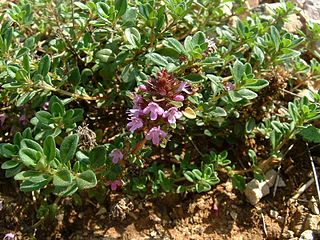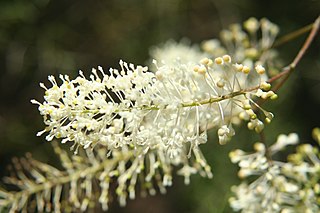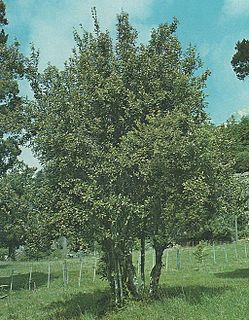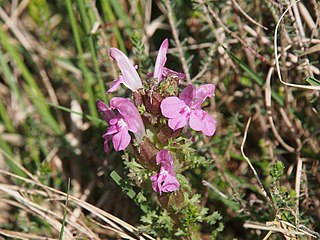
Thymus serpyllum, known by the common names of Breckland thyme, Breckland wild thyme, wild thyme, creeping thyme, or elfin thyme, is a species of flowering plant in the mint family Lamiaceae, native to most of Europe and North Africa. It is a low, usually prostrate subshrub growing to 2 cm (1 in) tall with creeping stems up to 10 cm (4 in) long. The oval evergreen leaves are 3–8 mm long. The strongly scented flowers are either lilac, pink-purple, magenta, or a rare white, all 4–6 mm long and produced in clusters. The hardy plant tolerates some pedestrian traffic and produces odors ranging from heavily herbal to lightly lemon, depending on the variety.

Grevillea leptopoda is a flowering plant originally found in Western Australia, mostly near Geraldton.

Hakea nodosa, commonly known as yellow hakea, is a shrub that is endemic to Australia. It usually has golden yellow flowers in profusion and needle-shaped leaves.

Protea coronata is an erect shrub usually growing 2-3 m tall, but known to reach 5 m. It produces an apple-green flower head and lanceolate leaves, turning purple-green around the flowerhead. Its stems are hairy. It flowers between April and September. The plant grows in dense stands on heavy clay soils in the Western Cape, South Africa,

Clarkia imbricata is a rare species of flowering plant in the evening primrose family known by the common name Vine Hill clarkia. It is endemic to Sonoma County, California, where it is known from only one remaining natural occurrence near Vine Hill. A second natural population located on private land was extirpated when the owners plowed up the soil crust. The California Native Plant Society has established a third population from cuttings and is tending it in a reserve. This is a federally listed endangered species.
Drosera subtilis is an erect annual species in the carnivorous plant genus Drosera. It is native to northern Western Australia and a single site in the Northern Territory. In Western Australia, it has been collected from Beverley Springs Station, Bigge Island, and the Mitchell Plateau area all in the vicinity of the Kimberley region. In the Northern Territory, it has been found near Little Nourlangie Rock. It grows over sandstone near seepage margins in skeletal sandstone sand and black humus mixed soils. D. subtilis is anchored to the soil by a system of thin, fleshy roots and it lacks a tuber. It produces small carnivorous leaves along erect, reddish stems that can be 20 cm (8 in) high.

Telopea aspera, commonly known as the Gibraltar Range waratah, is a plant in the family Proteaceae. It grows as a woody shrub to 3 metres (10 ft) high with leathery rough leaves and bright red flower heads known as inflorescences—each composed of hundreds of individual flowers. It is endemic to the New England region in New South Wales in Australia. It was formally described as a species by botanists Peter Weston and Mike Crisp in 1995, separated from its close relative Telopea speciosissima by its rough foliage and preference for dryer habitat. Unlike its better known relative, Telopea aspera has rarely been cultivated.

Lomatia hirsuta, known as radal, is a tree native to Argentina, Chile, and Peru.

Zieria laevigata commonly known as smooth zieria, smooth-leaved zieria or twiggy midge bush is a species of flowering plant in the citrus family Rutaceae and is endemic to eastern Australia. It is an erect shrub with smooth, three-part leaves and pale pink or white flowers with four petals and four stamens. It grows in poor soil on rocky outcrops and flowers from late winter to spring.

Sagina saginoides is a species of flowering plant in the family Caryophyllaceae known by the common names arctic pearlwort or alpine pearlwort. It has a circumboreal distribution; it can be found throughout the northern latitudes of the Northern Hemisphere. It grows in subalpine and alpine climates and other mountainous habitat at lower elevations. This is a small perennial herb producing a slender to threadlike stem just a few centimetres long, growing decumbent or erect. It is sometimes clumpy in form. The leaves are linear in shape and about 1 to 2 centimetres in length. The inflorescence is a solitary flower with five sepals and five small white petals.

Persoonia procumbens is a plant in the family Proteaceae and is endemic to part of the New England Tableland. It is a prostrate shrub with rather fleshy, relatively large leaves and small groups of cylindrical yellow flowers. It is similar to P. daphnoides but has darker hairs on the young branches and smaller, less hairy flowers.

Nothoscordum bivalve is a species of flowering plant in the Amaryllidaceae known by the common names crowpoison and false garlic. It is native to the southern United States from Arizona to Virginia, as well as Mexico, Peru, Uruguay, northeastern Argentina and central Chile.

Grevillea parallela, also known as silver oak, beefwood or white grevillea, is a tree native to northern Australia.

Persoonia coriacea, commonly known as the leathery-leaf persoonia, is a species of flowering plant in the family Proteaceae and is endemic to the south-west of Western Australia. It is an erect to spreading shrub with smooth bark, spatula-shaped or elliptic to linear leaves and bright yellow flowers borne in groups of up to ten along a rachis up to 70 mm (2.8 in) long.

Persoonia isophylla is a plant in the family Proteaceae and is endemic to New South Wales. It is an erect or spreading shrub with soft, pine-like leaves and groups of cylindrical yellow flowers. It is similar to P. pinifolia but the flowers of that species have small leaves at their base, where the flowers of P. isophylla have full-sized leaves at their base. The two species sometimes grow together but hybrids between them are rare.
Persoonia rufa is a species of flowering plant in the family Proteaceae and is endemic to the a restricted area of New South Wales. It is an erect to spreading shrub with hairy young branchlets, elliptic leaves, and yellow flowers borne in groups of up to twelve on a rachis up to 110 mm (4.3 in), each flower with a leaf at its base.

Hakea falcata, commonly known as sickle hakea, is a shrub in the family Proteacea and is endemic to southern Western Australia. It has narrow egg-shaped leaves, cream flowers and blooms in spring.

Grevillea trachytheca, commonly known as vanilla grevillea or the rough-fruit grevillea is a shrub of the genus Grevillea native to an area in the Mid West and Gascoyne regions of Western Australia.

Petrophile merrallii is a species of flowering plant in the family Proteaceae and is endemic to southwestern Western Australia. It is an erect shrub with spreading, needle-shaped leaves and oval to spherical heads of hairy yellow flowers.

Pedicularis sylvatica, commonly known as common lousewort, is a plant species in the genus Pedicularis. It is native to central and northern Europe where it grows on moist acidic soils, moorland, grassy heathland and the drier parts of marshes.






















